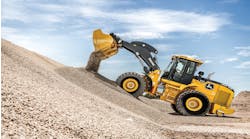With the windchill, it's 30 degrees below zero on the jobsite. Murphy's Law — anything that can go wrong, will go wrong — dictates that if the heater will ever break, this is the day.
But as ruthless as Murphy's Law might be, it can be countered with proper care and preventative maintenance before the first snowflakes fall. Regular checks throughout the season should help keep the heat circulating. If worse comes to worse, being familiar with troubleshooting tips for indirect-fired heaters will make faster work of repairs.
Preseason preparation
Don't wait until winter storms into the worksite before pulling out your portable, indirect-fired heater for initial checks. Look everything over while there's still time for replacing a part. Also, use this time to train anyone unfamiliar with indirect-fired heaters on the proper and safe use of the unit. Locate the operator's manual, preview the information and place it in a readily available location.
Next, walk around the heater, ensuring all decals and safety information are intact, undamaged and readable. If not, call the manufacturer to get some replacements on the way. Even experienced workers need reminders sometimes on fuel type and cautionary measures. Additionally, it can help protect you against negligence allegations.
Check out the ductwork, as well. You'll want to make sure it is adequate for the locations in which it will be used during the winter season. It is also important to check that none of the ductwork was torn or damaged during the off-season.
Next, start the heaters for a trial run and check their burning efficiency. Keep in mind that heaters will need to be tuned relative to the altitude in which they will be operating. Air thins as elevation increases, which will affect the air-fuel ratio necessary for complete combustion. With elevation changes, it may be necessary to change the fuel nozzle size or adjust the air band and shutters. Operating at higher elevations will require less fuel, more air or a combination of both.
A Bacharach Oil Burner Smoke Tester should be used to check and tune heaters to determine the amount of soot being carried by the exhaust gases. The tester consists of an air pump and probe. To use, insert the probe into the exhaust/chimney and pump 10 cycles of air. Afterward, remove the filter from the tester and hold it to the gray chart that accompanies the tool to determine if soot levels are appropriate. If not, adjust the air band and shutters to allow more or less air into the mixture. While the tester will cost a couple of hundred dollars, it'll be well worth the investment by preventing problems and maximizing efficiency.
Check it off once a day
Once the temperature drops and the heater season begins, start each day with a list of checks to ensure proper and safe operation. While the checklist may seem lengthy, each step will only take a matter of seconds. Once it becomes routine, it should take no more than a few minutes to look everything over before getting started for the day.
This list covers portable, self-contained heaters that also include a diesel-driven generator providing electrical power for the fans and motors. When using other models, you will still need to perform checks and preventative maintenance according to manufacturer's recommendations.
- Visually inspect the heater by walking around the outside. Ensure that all decals and safety warnings are still in place and legible and that no dirt accumulation could be disguising a problem. Look at the tires. Are they properly inflated and in good condition? Check for fuel or oil leaks, as well.
- Check the hitch assembly and safety tow chains (on self-towing models) to make sure that not only are the components securely in place but that they are not in need of repair. Inspect the jack, as well, to make sure it works properly.
- Make sure all of the lug nuts are torqued to about 80 or 90 foot-pounds. On new self-towing models, the lug nuts should be checked again after traveling the first 100 miles.
- Conduct a fluid check, ensuring that coolant, engine oil and fuel levels are sufficient.
- Look over the battery, making sure it is fully charged, that the terminals are tight and clean, and the electrolyte level is adequate.
- Ensure the ground rod and cable are undamaged so there's no question of the components functioning properly during operation.
- Confirm that the air cleaner is firmly attached and the air joints are sealed.
Don't forget the less frequent checks
While daily checks will help ensure the heater continues to run smoothly, a number of less frequent preventative steps will also help. For instance, check the engine air cleaner regularly for dirt build up. Service or replace it as necessary. Check the engine oil and filter regularly. Ensure the oil grade and viscosity aligns with the manufacturer's recommendations. If the running ambient temperature increases greatly from the starting temperature, strike a compromise and use a higher viscosity oil as long as the heater starts satisfactorily. Multigrade oils may overcome the differential if it has an appropriate specification.
Additionally, service the engine fuel filter according to the engine manufacturer's recommendations. Make note of what type of fuel is being used. The outside temperature not only affects working conditions, but the type of fuel needed for the heaters. No. 1 diesel is recommended, but blended fuels can be used if conditions allow.
Besides fuel type, check fuel pump pressure on the heater to ensure the level corresponds with the manufacturer's guidelines for that model. Inadequate pressure can cause poor starting and/or incomplete combustion, too much fuel pressure can cause the heater to soot up and burn very inefficiently.
Periodically, check the “cad cel” flame detector and clean with a nonabrasive cloth. The cad cell is inside the burner housing and typically will only need to be cleaned if the heater has not been tuned correctly. The cad cell looks for a flame. If it does not detect a flame — possibly because it is dirty — it will shut the heater down.
Every year, the high-limit switches should be replaced. The switches control the heat produced by cycling the fuel burner on and off as necessary to maintain the heat exchanger temperature. The fans will continue to provide airflow across the heat exchanger until a preset temperature is reached that will turn the oil burner back on.
It is possible to check the switches by restricting the discharge air. If the burner motor fails to cycle, the switches may need to be replaced as a safety measure. Under cold-weather conditions — say 10 degrees below with a single length of ductwork — the burners likely will not be cycling on and off very often. In unusual circumstances, such as 50 degrees with 75 feet of ductwork, the heater will cycle more frequently.
When replacing the switches, it is recommended to replace the fuel nozzles, as well. This should be done annually, but may need to be performed more frequently if the burner fails to operate properly. When the nozzles are replaced, check the burner electrode spacing and adjust as necessary. Similar to the spark plugs in your car, the electrode ignites the fuel. To adjust the electrodes, refer to the operator's manual for the correct dimensions and procedure.
When all else fails
So, what happens if you're reading this a bit too late? Or, what if the employee responsible for those daily checks wasn't quite as responsible as you expected? Understanding some basic troubleshooting methods will help turn around a problem more quickly than calling for a technician, saving both time and additional expense. Of course, never perform any maintenance you're not completely comfortable doing. In those cases, it's much better to call the technician.
By far the most common problem with an oil-fired heater's dependability is the most simple to prevent. It's important to ensure the correct fuel is being used seasonally. No. 1 fuel must be used during cold-weather months. Blended No. 2 diesel may work well for summer and early fall operations that require heat, but the No. 2 diesel will gel when it becomes cold. While additives may make No. 2 diesel more winter-ready, using No. 1 is the smartest choice.
Additionally, it is very important to use clean fuel. Your indirect-fired portable heater is not a waste oil heater. Using old oil or dirty fuel will bring dirt and contamination to the heater's fuel system. Problems caused by using incorrect or contaminated fuel only compound with time, so educating your employees on the necessity of always using clean, correct-grade fuel will pay dividends in the long run.
If the heater does not start, first attempt to use the manual reset button, per manufacturer-specific guidelines. If trouble persists, check the fuel level. Move on to inspect the fuel filter. Is the filter in need of servicing? If these are all fine, check the air bands and shutter settings and compare to the manufacturer's guidelines for the elevation in which it's being used.
If the heater is running but produces measurable soot or smokes, the fuel-air mixture is most likely not adjusted correctly for the altitude and conditions. This could be caused by a worn out fuel nozzle, a nozzle that is too large for the operating altitude, too much fuel pressure or not allowing enough air to the burner. Check the fuel pressure as well as air band and shutter adjustments. It is similar to adjusting an old carburetor for high altitude operation. The air fuel ratio needs to be correct for optimal performance.
Should the heater fans continue to run long after the heat exchanger has cooled, it may be time to replace the switch. An operable switch ensures that the fan turns on and off at established temperatures to keep the heated air moving and provides a cool down cycle for the heat exchanger when heat is no longer required.
Stick with this simple plan, and you'll have some pretty good insurance against Murphy and his inconvenient laws.
Doug Dahlgren is product manager for Holdrege, Neb.-based Allmand Brothers.





